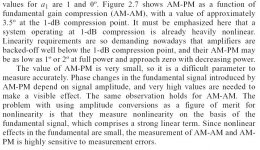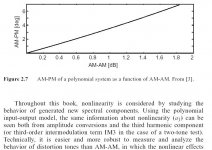traderbam said:Thanks for answering my question, PMA. These particular 'S' curves are more formally known as the tranconductance curves for the two input types. Nothing new here. But how about this claim of FM? What's the rationale behind this? Assuming this acronym was intended to stand for frequency modulation.
If i understood it right, you create FM distortion (dynamic phasehift ?) by distorting the difference of phasehifted signals (feedback). As the gain is not linear (S-curve/tanh) the amount of phaseshift correction is leveldependent. (can't be any good)
The easiest way out is using very high gain for the amp, giving minimal swing in diffamp. That's how symasym works, distortion in inputstage (openloop) is ~0.01%. But in this case undegenerated high transconductance bjts are more suitable.
Or the other way round, degenerate the diffamp like hell...
Mike
Ji John, yes i had read Gilbert's article, but i am not good enough in mathematics to follow all his equations.
It's a pity that his formulas are based on very poor opamps having low gain, high distortions and low bandwidth.
About the missing figures, seems like an issue from the webserver, i have the article at home on disk.
Mike
It's a pity that his formulas are based on very poor opamps having low gain, high distortions and low bandwidth.
About the missing figures, seems like an issue from the webserver, i have the article at home on disk.
Mike
john curl said:MikeB, have you carefully read Barrie Gilbert's article. The link to that article seems to have a problem with the figures. Is there a way around this?
Any better ?
http://archive.chipcenter.com/analog/c014.htm (edit: mod's if it does violate anything then please delete it.)
Thanks for the Gilbert article, guys. I have read this and understand it. The distortion caused by amplitude dependent phase shifts isn't rocket science. However, I may have missed something but I see no evidence of FM in this analysis or any of his error signal equations.
PMA, what evidence or analysis are you aware of to support your assertion that feedback around an integrator causes FM?
PMA, what evidence or analysis are you aware of to support your assertion that feedback around an integrator causes FM?
Folks, in the early days, like 1966-1974, we did not completely understand how to make faster amplifiers. In those days, there were NO power fets, and the F(t) of the best available power transistors was 4MHz, and usually it was lower than that for higher powered amplifiers. You know, the amps that were required when you did not own K-horns, (like I did at the time).
Solomon's paper, published in 1974, gave the essential equations that showed the problem of a high G(m) input stage vs slew rate. The only way around it, was either to use very high F(t) power transitors that were available to the military for about $100 each, OR to resistively degenerate the input differential pair. Today, you can more easily buy high F(t) transistors so you CAN get away with just using high F(t) transistors, but is this really the BEST way? Well, many of my 'critics' on this thread apparently have some invested interest in this approach. All I can say is, good luck.
I wish to give a parallel to this approach.
Many years ago, from 1932-1953 Ford made a V-8 engine based on a 'flathead' design. This was a VERY popular design in the USA, because there were so many Fords available second hand, that could then be raced. This is basicially a 'valve in block' design, that is very easy to work on, in many ways, BUT it had a real problem of air input restriction because of this sort of design. Chevy, at the time, used an 'overhead valve' design, but they only made a 6 cylinder engine, so it was less popular. Once Chevy, made an overhead valve V-8 engine, there was no contest for many years.
Well what about the thousands of 'flathead' Ford engines? Well, people went to superchargers, to overcome the intrinsic input restriction of the flathead engines.
There even used to be a cartoon duo of guys in an auto magazine wearing 'FLATHEADS FOREVER' on their T shirts. Where are they now? Over the years, people realized that tricking up a flathead, just wasn't worth it, when overhead valves, and then overhead cam engines became available and more affordable.
It is the same with the simple input bipolar differential pair.
Solomon's paper, published in 1974, gave the essential equations that showed the problem of a high G(m) input stage vs slew rate. The only way around it, was either to use very high F(t) power transitors that were available to the military for about $100 each, OR to resistively degenerate the input differential pair. Today, you can more easily buy high F(t) transistors so you CAN get away with just using high F(t) transistors, but is this really the BEST way? Well, many of my 'critics' on this thread apparently have some invested interest in this approach. All I can say is, good luck.
I wish to give a parallel to this approach.
Many years ago, from 1932-1953 Ford made a V-8 engine based on a 'flathead' design. This was a VERY popular design in the USA, because there were so many Fords available second hand, that could then be raced. This is basicially a 'valve in block' design, that is very easy to work on, in many ways, BUT it had a real problem of air input restriction because of this sort of design. Chevy, at the time, used an 'overhead valve' design, but they only made a 6 cylinder engine, so it was less popular. Once Chevy, made an overhead valve V-8 engine, there was no contest for many years.
Well what about the thousands of 'flathead' Ford engines? Well, people went to superchargers, to overcome the intrinsic input restriction of the flathead engines.
There even used to be a cartoon duo of guys in an auto magazine wearing 'FLATHEADS FOREVER' on their T shirts. Where are they now? Over the years, people realized that tricking up a flathead, just wasn't worth it, when overhead valves, and then overhead cam engines became available and more affordable.
It is the same with the simple input bipolar differential pair.
There was a mosfet (irf532/9532 probably) amplifier designed by IRF, that had normal undegenerated bipolar input LTP passively loaded and common emitter undegenrated VAS. There was no miller cap but huge resistor at VAS med-power transistor's base (!!!). Collector loading was mosfet pair. I think this is good example of high AM-PM (or FM) distortion generator.
Of course some 19+20kHz intermodulation test should reveal the fault, but who cares...
regards
Adam
Of course some 19+20kHz intermodulation test should reveal the fault, but who cares...
regards
Adam
Adam, I agree with you, WHEN there is a great deal of FM distortion. Why don't you try a test yourself and see how much FM modulation it takes to actually see it on another test, such as IM? I did run this test myself, about one year ago, with a Wavetek 166 function generator and an HP 3563 control systems analyser (FFT based) and it took a lot of modulation to get any visual results. However, I did not write down any specific numbers, so I will still rely on theoretical prediction for the moment and perhaps develop an FM discriminator just for this kind of measurement.
One possible reason why you can't find FM in your measurements is that it doesn't exist.
I'm seeking some engineering rigour, here.
JC you keep bandying "FM" about. Can you justify this...where is your analysis?
I presume you are aware of the difference between frequency modulation and phase modulation...
I'm seeking some engineering rigour, here.
JC you keep bandying "FM" about. Can you justify this...where is your analysis?

I presume you are aware of the difference between frequency modulation and phase modulation...
Mosfet inputs
I think the first Acoustat Transnova amplifier designed by James Strickland had a simple mosfet differential input stage. And Linsley-Hood published one too.
Bipolar inputs
What about a differential stage, very linear and with a high input impedance, using only bipolars in Sziklai pairs ?
I think the first Acoustat Transnova amplifier designed by James Strickland had a simple mosfet differential input stage. And Linsley-Hood published one too.
Bipolar inputs
What about a differential stage, very linear and with a high input impedance, using only bipolars in Sziklai pairs ?
- Status
- This old topic is closed. If you want to reopen this topic, contact a moderator using the "Report Post" button.
- Home
- Amplifiers
- Solid State
- FET inputs or bipolar inputs on a power amp?

